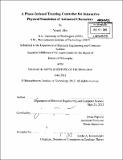| dc.contributor.advisor | Jovan Popović. | en_US |
| dc.contributor.author | Abe, Yeuhi | en_US |
| dc.contributor.other | Massachusetts Institute of Technology. Dept. of Electrical Engineering and Computer Science. | en_US |
| dc.date.accessioned | 2012-11-19T19:15:33Z | |
| dc.date.available | 2012-11-19T19:15:33Z | |
| dc.date.copyright | 2012 | en_US |
| dc.date.issued | 2012 | en_US |
| dc.identifier.uri | http://hdl.handle.net/1721.1/74887 | |
| dc.description | Thesis (Ph. D.)--Massachusetts Institute of Technology, Dept. of Electrical Engineering and Computer Science, 2012. | en_US |
| dc.description | Cataloged from PDF version of thesis. | en_US |
| dc.description | Includes bibliographical references (p. 103-107). | en_US |
| dc.description.abstract | In this thesis, I describe a method of animating characters using physical simulation. The main advantage of this approach, verses traditional keyframing methods, is that the animated character can react to physical interactions. These reactions can be synthesized in real-time in interactive applications, such as video games, where traditional approaches can only playback pre-recorded sequences. Physically simulating a character requires a controller, but creating a controller is known to be a challenging task, especially when animation concerns about the style of the motion are taken into consideration. This thesis describes a method of generating a controller automatically and quickly from an input motion. The stylistic aspects of the controller are particularly easy to control, as they are a direct result of the input motion. In order to generate a controller from an input motion, I address two main challenges. First, the input motion must be rectified (minimally modified) to ensure that it is physically plausible. Second, a feedback strategy must be formulated to generate control forces during the simulation. The motion rectification problem is addressed by formulating a fast trajectory optimization that solves for a reference motion. The reference minimally deviates from the input motion to satisfy physical constraints. The second challenge is addressed by employing a novel phase-indexed controller that uses a combination of local and global feedback strategies to keep the character tracking the reference motion. Beyond tracking just a single reference motion, I also demonstrate how variation to a input motion can be automatically synthesized using the same trajectory optimization method used in the rectification process, and how these variations can be sequenced, using optimal control, to accomplish various goals. | en_US |
| dc.description.statementofresponsibility | by Yeuhi Abe. | en_US |
| dc.format.extent | 107 p. | en_US |
| dc.language.iso | eng | en_US |
| dc.publisher | Massachusetts Institute of Technology | en_US |
| dc.rights | M.I.T. theses are protected by
copyright. They may be viewed from this source for any purpose, but
reproduction or distribution in any format is prohibited without written
permission. See provided URL for inquiries about permission. | en_US |
| dc.rights.uri | http://dspace.mit.edu/handle/1721.1/7582 | en_US |
| dc.subject | Electrical Engineering and Computer Science. | en_US |
| dc.title | A phase-indexed tracking controller for interactive physical simulation of animated characters | en_US |
| dc.type | Thesis | en_US |
| dc.description.degree | Ph.D. | en_US |
| dc.contributor.department | Massachusetts Institute of Technology. Department of Electrical Engineering and Computer Science | |
| dc.identifier.oclc | 813960020 | en_US |
